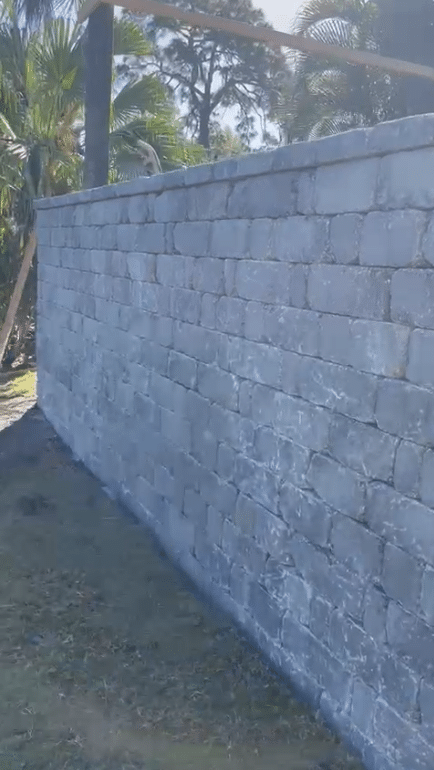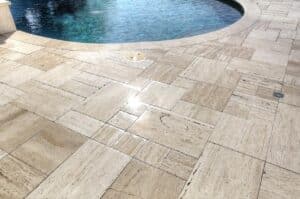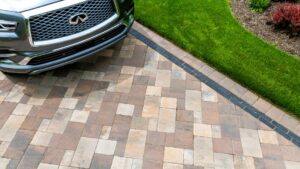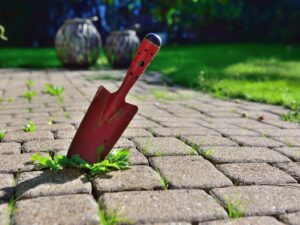Did you know retaining walls and driveways go hand-in-hand? When it comes to functionality and aesthetics in the hardscape industry, this duo is tough to beat.
The main purpose of retaining walls is to hold back dirt wherever there is a steep change in elevation within your property, which could cause erosion. However, with the current variety of materials and colors available, retaining walls can easily help you control damage caused by erosion and maximize space in your driveway – all that while looking amazing!
One of the most important things to consider when planning your new driveway is the type of retaining wall you want – whether you’re looking to cut or fill the surrounding land.
In this post, we will talk about the two ways of building a retaining wall for driveways and tell you all the important details to consider when planning them.
So, let’s get started with everything you need to know about retaining walls for driveways!
Cut Retaining Walls (Driveway Along Retaining Walls)
This is the type of wall that you’re going to build when you need to extend your driveway in order to make it longer and more approachable. Since there is no traffic happening on top of this retaining wall, it’s not necessary to account for the load caused by vehicles, which makes designing one a much simpler process.
In order to minimize the chances of an accident, we recommend you to include a curb or a parking stop at least 4 feet away from the retaining wall. You probably wouldn’t want someone to run into your retaining wall, right?
Fill Retaining Walls (Driveway Above Retaining Walls)
This is the kind of wall that you’re going to build up your driveway if you need to compensate for unstable land and sloped terrain. However, since the driveway will be on top of the retaining walls, accounting for the load on the driveway is necessary. A good rule-of-thumb is to consider around 150lbs/sq. ft. for cars and around 250lbs/sq. ft. for trucks, but your mileage may vary.
As with cut retaining walls, there are some safety measures that should be taken in every situation. For fill retaining walls, placing a parking cub and a guard rail are good ways to keep your structure safe.
Key Things to Consider When Designing a Retaining Wall for a Driveway
Material Choice
Retaining wall stones come in a wide variety of materials, shapes and colors. While they can complement any style of driveway, choosing the ideal material for your wall is important.
Brick retaining walls, for example, are extremely durable, making them a top choice for traditional driveways. Timber retaining walls look amazing when combined with rustic homes and tend to integrate themselves nicely with the surrounding landscape. On the other hand, their lifetime tends to be shorter than the other options.
Another common choice of material for driveway retaining walls is concrete, which is strong, extremely versatile and blends well with your yard, garden or home’s exterior. Concrete pavers also tend to be cheaper than the alternatives and be easier to maintain, making it the go-to material for most projects.

Building Codes
Don’t forget to check local building codes to avoid getting in trouble with the law and ensure your driveway’s safety!
It’s common for codes to ask a design by qualified engineers if the retaining walls are supposed to be taller than 4 feet. In some places, adding guard rails or fences will be mandatory for retaining walls reaching 3 or 4 feet.
A Drainage System
Water collecting in the wrong places is an easy way to wreak havoc on hardscaping elements. It is no different with driveways and retaining walls, so ensuring water is being properly drained is of utmost importance to ensure those structures will be long-lasting.
“Why is draining retaining walls important?” you might ask. Since water tends to follow the path of least resistance towards the ground, dirt from behind the wall erodes and ends up redeposited on its front, creating a pressure gradient that will, eventually, cause the wall to move or even fail.
Vehicle Load
If you are building a driveway over a retaining wall, you will have to take the vehicles’ load into account. You will have to consider and take extra care if you have more than one car or if you have a truck, which will require additional reinforcement for your retaining wall.
Addition of Guard Rails
While not obligatory, they are nice to have as a safety measure as they can prevent people and drivers from slipping off your new retaining wall. Guard rails may also enhance the look of your driveway and increase the value of your property. Alternatively, you could go for fences even if they are not mandatory.
No matter what your choice is, make sure to discuss the details with your engineer to ensure they are the safest they can be.
Professional Help
It’s undeniable that well-built retaining walls for your driveway will look amazing once completed. However, when it comes to building one, you’re better off hiring qualified professional help to ensure your driveway project will come out as planned.
We here at S&S Pavers have helped countless homeowners with retaining wall projects in the Sarasota and Manatee counties – be it building the structure of your dreams or general maintenance services for your pavers. We understand how important it is to work alongside professionals to ensure everything goes as smoothly as possible.
If you happen to be around our area, why not give us a call for consultation about all things hardscaping?
You can contact us at any time for a free estimate on our services. Call us right now at 941-773-3098 or send an email to sales@sspavers.com. We would be happy to hear from you.




